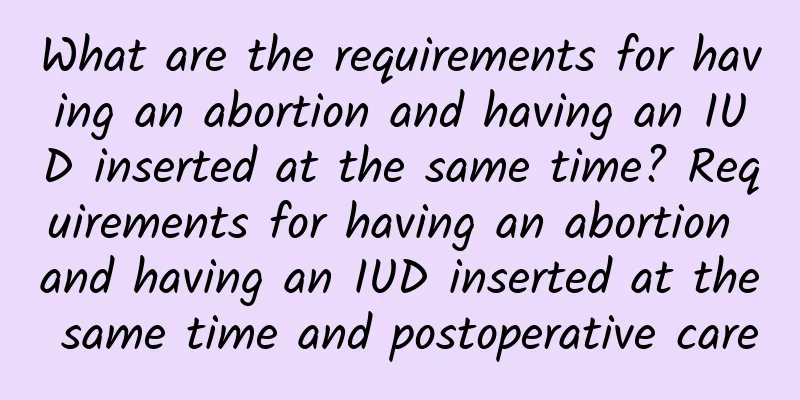What are the requirements for having an abortion and having an IUD inserted at the same time? Requirements for having an abortion and having an IUD inserted at the same time and postoperative care

|
It is medically possible to have an abortion and an IUD at the same time, but it must meet certain requirements. If the requirements are not met, the IUD cannot be inserted. It must be performed after the abortion. So what are the requirements for having an abortion and an IUD at the same time? What kind of postoperative care should the patient do after the IUD is inserted? Let's learn about the requirements and postoperative care for having an abortion and an IUD at the same time. I hope that through my explanation, everyone can understand it. First, you have to go to a regular hospital, because such hospitals will make a comprehensive judgment based on the patient's actual hospital condition, and the surgical sterilization measures are good, and the chance of surgical infection is small. Second, it depends on the gestational age at the time of surgery, because a smaller uterus will contract better after surgery and the insertion of an IUD will not cause bleeding; while a larger gestational age will cause the uterus to contract poorly after surgery and is prone to bleeding and infection. Third, we need to see how the uterus contracts after the abortion. If the uterus contracts well, the IUD can be inserted. If the uterus contracts poorly, the IUD cannot be inserted, and we must take good measures to prevent infection after the operation. If all three of the above conditions are met, it is possible to have a painless abortion and an IUD insertion at the same time. If not, the best time to have an IUD insertion is one month after the abortion, when normal menstruation resumes, and within 3-7 days after the menstruation is clean and there is no blood. The following situations are not suitable for immediate IUD insertion: 1. Those who have poor uterine contraction, heavy bleeding, and repeated vaginal bleeding before the operation may have residual pregnancy tissue or infection; 2. Postoperative examination of the aspirate is suspicious, such as benign or malignant hydatidiform mole; severe cervical erosion or genital tumors; 3. Malformations of reproductive organs, such as double uterus, bicornuate uterus, etc.; 4. Patients with various serious systemic acute and chronic diseases, such as severe anemia, blood diseases and acute stages of various diseases, please follow the guidance of experts for specific circumstances. Things to note after having the IUD inserted: 1. Pay attention to hygiene and avoid infection: After the ring is inserted, the vulva should be washed every day to keep it clean. 2. Get adequate rest and avoid heavy physical labor: Generally, you should rest for 1-2 days after the ring is placed. Do not do heavy physical labor within a week to avoid causing the ring to fall off and bleeding. 3. Regular check-ups: Generally, the first check-up after the placement of the ring is after the first menstruation, the second check-up is within 3-6 months after the placement of the ring, and the third check-up is a review 12 months after the placement of the ring, and then a review once a year. 4. Pay attention to vaginal bleeding and ring shedding: If you find that the vaginal bleeding is heavy, more than double the normal menstrual blood volume or the bleeding time is long, and the menstrual cycle changes are obvious, you should go for a check-up in time. In the first 3 months, you should also pay attention to whether the ring has fallen off. After an abortion and an IUD are inserted, the body is more susceptible to infection. During this operation, you must pay attention to disinfection. Therefore, when choosing an abortion hospital, patients must choose a local regular hospital to prevent infection after the operation and are more likely to suffer from gynecological diseases. After the abortion, patients need to do postoperative care to help the body recover. |
>>: Does cervicitis affect pregnancy? Revealing the impact of cervicitis on pregnancy preparation
Recommend
Diabetes causes morbid obesity! Surgery should be evaluated
Although gastric bypass surgery is effective in c...
What will happen if you don't see a doctor if you have vaginitis?
Vaginitis is a common reproductive tract infectio...
A brief analysis of the hazards of four major painless abortions
Painless abortion is a more frequently used abort...
What are the symptoms of ovarian cysts? At what age do ovarian cysts appear?
What are the symptoms of ovarian cysts? At what a...
What are the types of multiple uterine fibroids?
Clinically, the incidence of multiple uterine fib...
Is it healthy and hassle-free to eat nuts and avocados to lose weight? "These 7" healthy foods will make you fat if you lose control
If your weight loss plan fails, the problem may b...
Cervical hypertrophy can be seen through some leucorrhea characteristics
Cervical hypertrophy can be seen through some cha...
Drinking chocolate milk after exercise can help you build muscle and lose fat? Nutritionist answers…
Friends who have the habit of exercising must hav...
Will conservative treatment of ectopic pregnancy expel the gestational sac?
Conservative treatment of ectopic pregnancy may r...
Are office workers suffering from internal injuries due to so much stress? Famous Chinese medicine doctor: Try rubbing the abdomen and raising the arms to effectively help regulate the spleen and stomach
Abdominal massage is a method of health preservat...
What to eat after medical abortion? Doctors recommend these 3 foods
Medical abortion is a very helpless choice for fe...
Can bacterial vaginosis cause dysmenorrhea?
Can bacterial vaginosis cause dysmenorrhea? 1. Ba...
What are the nursing methods for patients with Bartholinitis?
The cause of Bartholinitis is related to many fac...
What are the symptoms of pelvic fluid during ovulation?
Many friends who are working have little time to ...
Detailed introduction to several causes of menopause
If menopausal patients are not treated, they will...









